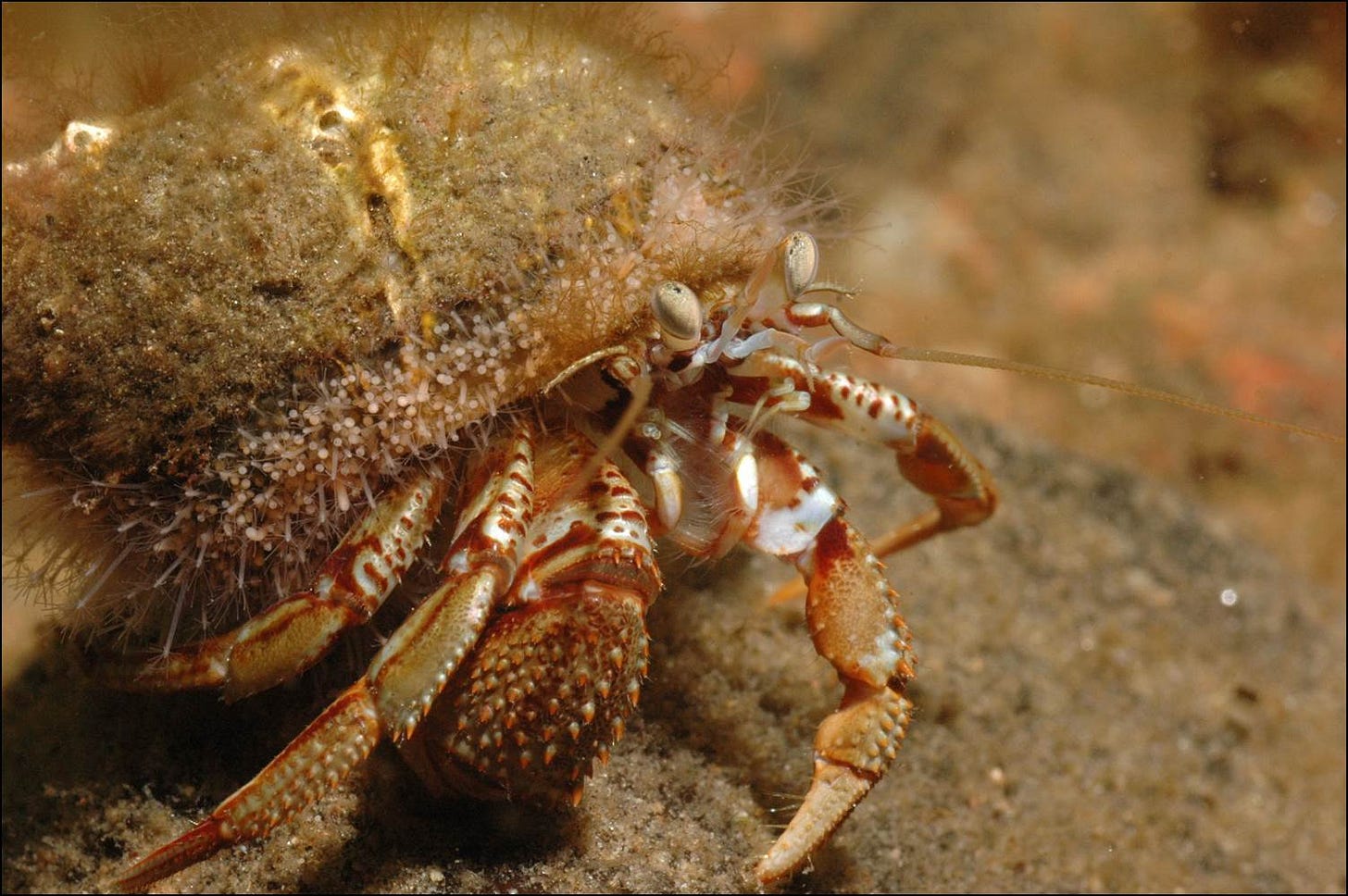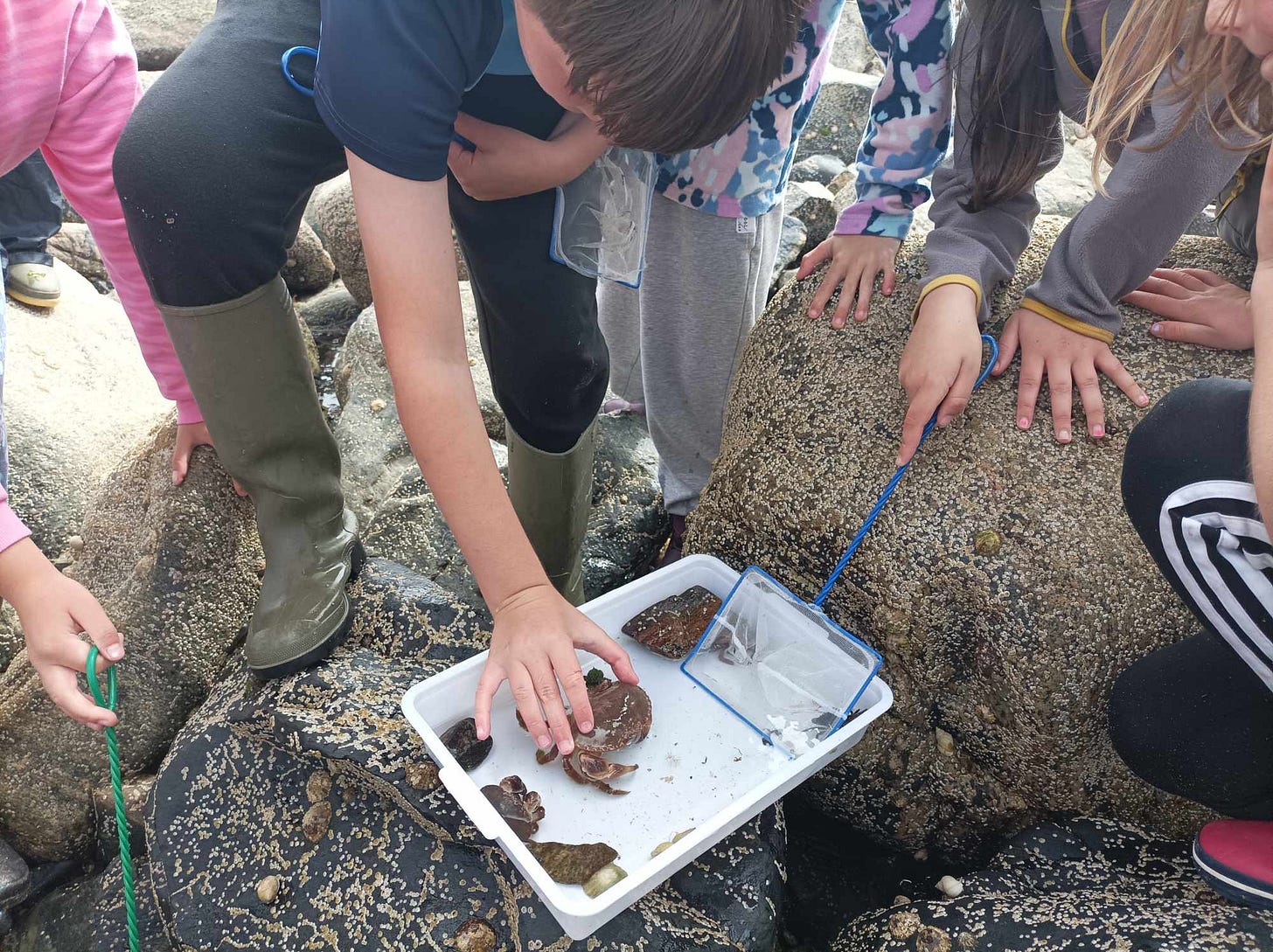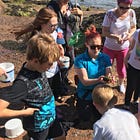Tales from the Tidal Zone - Hermit crabs
Andy tells us about a close encounter with a hermit crab
Nothing much seemed to be going on and then suddenly it happened. An apparently empty dog whelk shell wobbled a bit and out appeared some legs and a claw. A hermit crab had taken up home in the empty shell.
A group of children were exploring the amazing world of rockpools and the shoreline with the Ranger Service. We had collected all sorts of incredible creatures and were putting them in a tray for closer observation - a typical method of seeing these creatures without harming them. Among the brittle starfish, green ribbon worm and numerous pea crabs that we had caught, were the inevitable hermit crabs.
Children (and adults) are fascinated by hermit crabs.
While most of the children were turning over stones, arms buried in seaweed looking to see what more treasures they could find, myself and a ten-year-old were hunched over the tray just watching. We had been gazing at the little scene in the tray for several minutes. I lost track of time. The girl was motionless and transfixed by what we were witnessing, oblivious to the noise and excitement of her friends around her. I could feel in a very real sense there was a connection between the girl and nature in its most raw. We didn’t speak. There was nothing to say.
As we watched the hermit crab searched around its new environment and very quickly homed in on an empty dog whelk shell. There was a most cursory check to see nobody was home in the new shell and then, as quick as a flash, it had moved. Trying the new house for size. Hermit crabs are very vulnerable when exposed outside their adopted shell. There are always predators looking for the chance of an easy meal. Hermit crabs look funny without their adopted shell. The soft body has a hooked tip which it uses help them grip into their shell. But as quick as it had moved in, our little hermit crab decided it was no good and it moved back. Maybe it was too big or maybe too small but for whatever reason the new shell was rejected. A crab will use its stalked compound eyes to gauge a shell’s size, weight and even colour, and it also has a good feel, using its legs and antennae, to estimate the shell’s volume, shape, condition and manoeuvrability, and whether it is already occupied. Gathering and processing all this information is a remarkable cognitive feat. Recently scientists discovered that if hermit crabs ingest microplastics, their decision-making is impaired, disrupting this essential survival behaviour.
Hermit crabs live inside empty sea snail shells, particularly those of dog whelks and periwinkles. They are opportunistic scavengers, feeding on anything they can find. They have tough pincers but a soft body. As they grow, hermit crabs are forced to move into ever larger shells. I once had a friend from the Caribbean who told me he once saw an amazing sight of a Nescafe coffee jar walking along the beach. A hermit crab living there had grown so big it could not find a natural shell large enough to accommodate it huge body and had found this discarded coffee jar. It seemed to do the trick although we don’t encourage folk to leave litter on the beach even though it found a good use. There are many instances of hermit crabs wearing our rubbish – bottle tops and plastic lids being the most common.
Sometimes moving house is not a peaceful affair. The demand for a new “house” can mean fights. When two hermit crabs meet, one may attempt to steal the other's shell by forcibly evicting the current owner. The aggressor will knock on the shell it wants, drawing out the owner and fighting it out until one emerges victorious.
Alternatively, if a crab locates one that’s not the right size, it will patiently wait nearby until another crab looking for a new shell arrives. When that crab sheds its old home and takes the empty shell, our first crab moves into that newly vacated one, casting off its own, which is then adopted by a smaller crab... and so on. The number of house- swaps each crab undertakes in its life varies depending on water temperature and habitat.

Hermit crabs can live for an average of 5 years in the UK, although there are instances of crabs living for 10-20 years and one record of a hermit crab over 30 years old. So please treat them with care and respect – they are awesome creatures.
Another interesting thing about hermit crabs is there is tendency to attach anemones to their shell, and they will even transfer them from shell to shell when they move house. The anemones' stinging tentacles may deter predators. And the anemone gets to travel around more than it would normally.
That day at Clashnessie, as well as many hermit crabs the children also found a beautiful squat lobster and lots of other amazing things as well including broad-clawed porcelain crab, dog whelk eggs, dahlia anemones and much more. Make sure when you are rockpooling along the shore to respect these creatures you find. Treat with care and don’t leave them in a bucket for very long. Even if full of water the it can get very warm in the bucket and the oxygen levels diminish very quickly. If you turn over a stone, make sure you return it to where it was. This is a home for so many creatures.
Andy Summers, North Highland's Senior Ranger for High Life Highland, is a dedicated naturalist with a deep understanding of the region's diverse ecosystems. His extensive experience in wildlife conservation and passion for preserving North Highland's pristine landscapes make him a vital asset. Andy's work encompasses wildlife observation, environmental education, and passing on a greater appreciation for the area's unique flora and fauna. His commitment to conserving North Highland's natural heritage is evident in his expertise and unwavering dedication.











